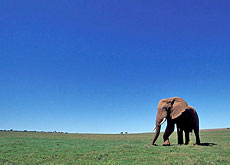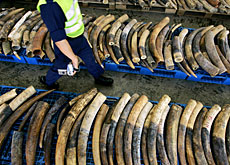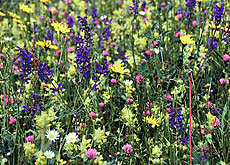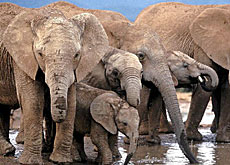Swiss hail “important progress” on ivory trade

The Swiss delegation at a heated two-week conference on protecting endangered species has welcomed an agreement on elephant ivory exports.
The 171-member Convention on International Trade in Endangered Species (Cites) endorsed a compromise by African ministers on halting poaching while letting local communities benefit from ivory sales in regions where elephant numbers are rising.
In the early hours of Friday, the last day of the conference in The Hague, African nations agreed to a massive ivory sell-off and a nine-year freeze on further sales, in a move conservationists hoped would mean a reprieve for elephant herds from poachers and smuggling syndicates.
Switzerland supports the opening of a limited ivory trade – under certain conditions, according to the Federal Veterinary Office, who described the agreement in a statement as “important progress”.
The issue of elephant ivory has dominated every meeting of Cites, for whom Switzerland is the depositary country, for decades.
Delegates said the compromise, reached after days of disputes, would now allow the regulatory body to focus its energies on other species facing heightened threats from globalisation, climate change and diseases such as bird flu.
In addition to the progress made on ivory at the conference, the Federal Veterinary Office also welcomed future tests on the sustainability of red coral and the freshwater eel.
Milestone
The compromise on the trade of ivory effectively called a truce in the recurring tussles between those African countries wanting to cash in on stocks of accumulated tusks and those who fear that easing Cites’ 1989 trade ban would put more pressure on their dwindling elephant herds.
Cites approved the deal in what the European Union called a milestone for the wildlife trade organisation.
The arrangement allows South Africa, Namibia, Botswana and Zimbabwe to empty government inventories in a single sale to Japan, which guaranteed not to re-export the raw ivory. Revenues from the sale are earmarked for conservation programmes.
With careful management, herds in the southern African states have rebounded over the past 18 years, but poaching has plagued countries in West and Central Africa where plundered natural resources have fuelled civil wars.
“This African solution to an African problem marks a great step forward for wildlife conservation,” said Cites secretary-general Willem Wijnstekers. African nations had never before agreed a common ivory front at Cites, which meets every three years.
“It’s good news for the elephant, good news for the people who live alongside them and good news for regional cooperation in Africa,” added Wijnstekers.
“Poachers’ charter”
However, some environmentalists worried the one-time sale would stimulate a demand that could not be legally met.
“It will encourage the illegal market, and that’s what kills elephants,” said Michael Wamithi, a Kenya-based elephant expert for the International Fund for Animal Welfare.
It also sends a signal to consumers “that ivory is back in style,” he said.
The Lausanne-based IWMC World Conservation Trust branded the deal a “poachers’ charter”, saying it would deprive African nations doing most to conserve elephants of export revenues for nine years.
However, Cites chief enforcement officer John Sellar said the legal trade could ease the pressure for smuggled ivory.
swissinfo with agencies
The Cites conference took place in The Hague, the Netherlands, from June 3-15.
The Swiss delegation comprised two people from the Veterinary Office, and one each from the Foreign Ministry and Environment Office.
In addition, the Veterinary Office’s director, Hans Wyss, attended Cites’s first ministerial debate, organised by the Dutch government, on June 13.
Cites was set up in 1973. It is an international agreement between governments that aims to ensure that international trade in specimens of wild animals and plants does not threaten their survival. It has 171 members, who meet every two to three years.
Around 30,000 types of plants and animals are offered varying degrees of protection by the accord.
The international trade in wildlife is estimated to be worth billions of dollars annually and to involve more than 350 million plant and animal specimens every year.
Switzerland is the depositary state of Cites and the Cites secretariat is in Geneva.
Cites provides three regulatory options in the form of Appendices.
Appendix I: animals and plants are excluded from international commercial trade except in very special circumstances. Includes great apes, big cats such as cheetahs and tigers, and some orchids. Covers 530 animals and more than 300 plants.
Appendix II: trade is permitted but strictly controlled on the basis of Cites permits. Covers more than 4,460 animals and 28,000 plants.
Appendix III: includes species that are protected in a member country’s borders. By listing a species, a country calls for help in regulating the trade in the species. Covers more than 290 species.

In compliance with the JTI standards
More: SWI swissinfo.ch certified by the Journalism Trust Initiative












You can find an overview of ongoing debates with our journalists here . Please join us!
If you want to start a conversation about a topic raised in this article or want to report factual errors, email us at english@swissinfo.ch.